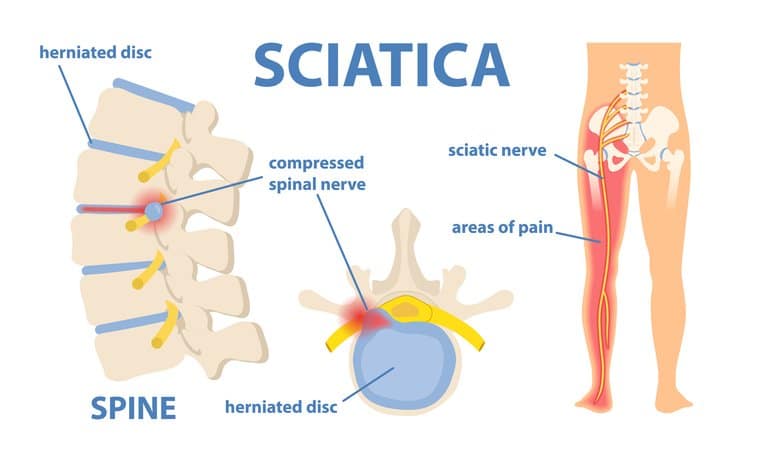Have you been experiencing pain from the lower back that travels down the leg? You may be suffering from sciatica, caused by pressure/irritation on the sciatic nerve.
Sciatica refers to pain in the buttock and leg, caused by pressure and/or inflammation of the sciatic nerve. The sciatic nerve is a large nerve that arises off the spinal cord from smaller nerve roots exiting the spine at the spaces between the discs. Form here it runs out through the back of your pelvis and buttock and continues down the back of your leg.
There are multiple sites along the course of sciatic nerve where it can become compressed or inflamed, the most common including:
- disc herniation pushing on the nerve as it exits off the spinal cord
- bone spurs due to arthritis on the spine narrowing the space where the nerve exits the spine
- tight muscles in the pelvis/buttock causing compression on the nerve

Symptoms of Sciatica
The sciatic nerve carries information back and forth from the spine to the leg and foot, regarding sensation (touch) and motor control (movement). Pressure and inflammation at any site on the nerve can cause considerable pain down the full length of the nerve. The most common symptoms experienced with sciatica are:
- sharp shooting, electric-type pain down the leg

- aching pain down the back of the leg
- hot pain in the buttock
- pain in the ankle/foot
- pins and needles in the leg/foot
- weakness/heaviness in the leg/foot
Sciatica can be treated conservatively, with most patient's symptoms fully resolving in 6-weeks to 3-months, depending on the cause. Not all pain travelling down the leg is sciatica, so it is important you see a qualified health practitioner who can diagnose your condition, as treatments can vary significantly. Your chiropractor will do a comprehensive examination on the functioning of the nerves coming from your lower back to assess whether there is compression upon one of the nerves. In some cases scans may be required to assess what is causing your sciatica, and how best to help you recover.
How is Sciatica treated?
The recommended first line of treatment for sciatica involves a combination of:
- nerve gliding/flossing mobilisation techniques to reduce tension on the sciatic nerve
- spinal manipulation
- joint mobilisations
- soft tissue muscle release
- core stability exercises
- advice on ergonomics and posture, to reduce irritation of the sciatic nerve
If symptoms aren't improving with first line conservative treatments, patient may require referral back to their GP for pain medications and in some cases cortisone injections, depending on the cause of sciatica.
Chiropractors are well trained in the diagnosis and treatment of sciatica, and our team at Flex Health Professionals are ready to help!
